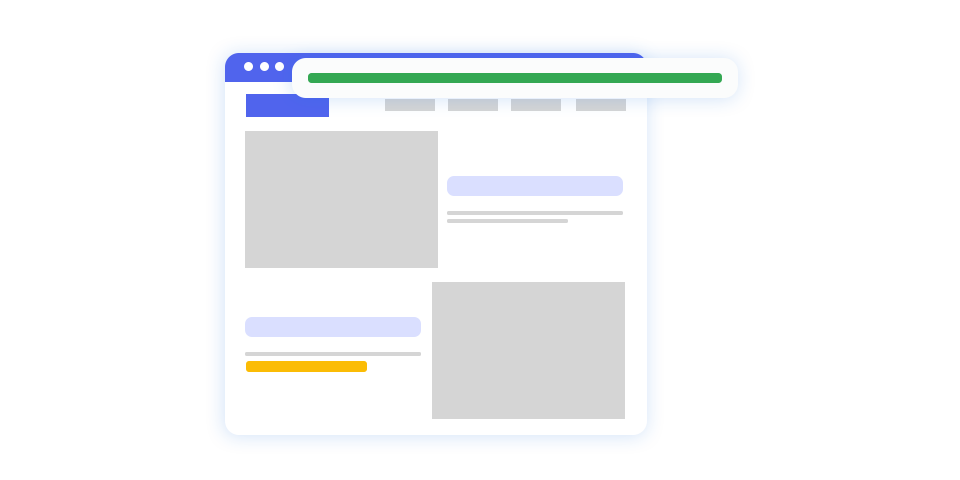A pillar page is the main foundation for a group of related articles. It covers everything about a topic in one place, and you can have more detailed articles linked to it for in-depth information. It’s important to carefully think about, plan, and create well-designed pillar pages. When they look good, it’s easier to share them, and people may link to them on their own. Good design also makes it simpler for users to understand and grasp more complicated topics. There are two parts to a pillar content strategy: One of them is the Pillar Page and the other one is the Cluster Page.
What Are Topic Clusters?
Topic clusters are a way of organizing content on a website around a central “pillar” topic. A pillar page serves as the main page for a broad subject, covering its core aspects. Surrounding the pillar page are related articles or blog posts, known as cluster content, each delving deeper into specific subtopics related to the main theme. The cluster content links back to the pillar page and interconnects, creating a comprehensive and organized structure. This approach helps search engines understand the context and relevance of the content, potentially improving the website’s visibility in search results.
What Is a Pillar Page?
A pillar page acts as the central hub for a specific topic, surrounded by related articles or blog posts known as a topic cluster. This organizational strategy, often referred to as the hub and spoke model, involves interlinking content to provide a comprehensive understanding of a subject. For instance, consider a pillar page titled “Healthy Living Guide.” This serves as the main hub, while the cluster articles, such as “Nutritious Meal Ideas” and “Effective Home Workouts,” revolve around this central theme. The pillar page links to each cluster article, and vice versa, forming a structured network of information. Pillar pages commonly take the form of ultimate guides, addressing queries like “Essentials of a Balanced Diet” or “Best Exercises for Home Fitness.” These types of searches indicate users seeking solutions to specific problems. By presenting a well-crafted pillar page demonstrating expertise on the subject, your website not only provides valuable solutions but also positions itself as a go-to resource for users seeking information in that domain.

How Pillar Pages Can Help Your SEO?
Google’s way of finding answers is always getting better. They’ve made some recent changes. Now, if a website has too many unnecessary links, it might not show up as much. Also, when people type questions, Google tries to understand the whole question, not just individual words. Plus, they use machine learning to figure out what words mean, so they can show more accurate results. These changes are meant to make searching online better by giving people more exact and useful results. In many blogs, including ours until recently, people usually make separate blog posts to rank for certain words. This makes things messy and makes it tough for users to find the information they want. It also makes your own website compete against itself in search rankings when you have lots of posts about similar topics.
Pillar pages can significantly boost your SEO (Search Engine Optimization) efforts in several ways:
Content Organization
Pillar pages help organize your content effectively. By serving as the central hub for a particular topic, they create a clear structure that search engines can understand. This organization improves the user experience and makes it easier for search engines to index and rank your content.

Internal Linking
The pillar page and its associated cluster content rely on internal linking. Internal links between the pillar and cluster pages establish a strong connection within your website, signaling to search engines the relevance and relationship between these pieces of content. This helps search engines understand the context and hierarchy of your information. By linking other pages that dive deeper into specific details or related aspects of the main topic, you’re building a network within your website. Visitors can smoothly move from the main pillar page to more specific information and back again. This not only improves the user experience, making navigation a breeze, but it also tells search engines that your website is well-organized and authoritative on the chosen subject.
Keyword Optimization
Pillar pages naturally incorporate key terms and phrases related to the overarching topic. This aids in keyword optimization, making your content more likely to appear in relevant search results. When users search for broad topics, the pillar page is designed to capture their attention, and from there, they can explore more specific cluster content.
Authority Building
By creating comprehensive pillar pages, you demonstrate authority and expertise on specific subjects. This not only attracts users seeking in-depth information but also establishes your website as a credible source. Search engines tend to favor authoritative content, potentially leading to higher rankings in search results.
User Engagement
Well-constructed pillar pages provide a better user experience. Users can find all-encompassing information on a particular topic in one place, reducing the need to navigate through multiple pages. This improved user experience can contribute to lower bounce rates and longer time spent on your site, both of which are positive signals for search engines.

Backlink Opportunities
Compelling pillar content has the potential to attract backlinks naturally. When other websites find your pillar page valuable, they may link to it, contributing to the overall authority and credibility of your website. Backlinks remain a crucial factor in SEO, and pillar pages can serve as link-worthy resources. In summary, pillar pages play a vital role in improving your website’s SEO by providing a structured, well-linked, and authoritative approach to content. This, in turn, can positively impact your visibility in search engine results and drive organic traffic to your site.
How to Create a Pillar Page?
A pillar page is a key page. It has lots of useful information, uses important words, and is well-organized. That’s why it’s crucial to follow the steps below.
1. Define Your Content Strategy
- Identify your target audience and their needs.
- Align your pillar page topic with your overall content strategy and business goals.
2. Conduct Thorough Research
- Explore trending topics and keywords in your industry.
- Analyze competitors’ content to understand gaps and opportunities.
3. Choose a Broad Topic
- Select a broad, overarching topic that is relevant to your audience.
- Ensure the topic has sufficient depth to allow for the creation of subtopics.
4. Identify Subtopics (Clusters)
- Divide the main idea into smaller parts or groups.
- Each subtopic should be a specific aspect that provides more detailed information.
5. Keyword Research
- Utilize tools such as Google Keyword Planner to discover keywords that are related and important.
- Integrate these keywords naturally into your pillar page and cluster content.
6. Create a Content Plan
- Outline the structure of your pillar page, including key sections and subheadings.
- Plan the individual articles for your cluster content, aligning them with the subtopics.
7. Write High-Quality Pillar Page Content
- Craft an engaging introduction that clearly defines the main topic.
- Provide comprehensive information, covering all essential aspects of the topic.
- Use a conversational tone to make the content accessible to a wide audience.
- Incorporate visuals such as images, infographics, or videos to improve engagement.
8. Develop Cluster Content
- Write separate, detailed articles for each subtopic identified in your content plan.
- Ensure that each cluster piece adds value and expands on the information on the pillar page.
9. Internal Linking Strategy
- Implement a strategic internal linking strategy.
- Link each cluster article back to the main pillar page, emphasizing the interconnected nature of the content.
10. Optimize for SEO
- Enhance your content for search engines by incorporating pertinent keywords.
- Create descriptive meta titles and meta descriptions for each page.
- Ensure proper heading hierarchy (H1, H2, H3) for readability and SEO.
11. User-Friendly Design
- Design a visually appealing and easy-to-navigate pillar page.
- Implement clear headings, subheadings, and a logical flow of information.
- Ensure a mobile-friendly design for a seamless user experience.
12. Promote Your Pillar Page
- Share your pillar page on social media platforms.
- Include it in your email newsletters and any relevant marketing campaigns.
- Consider reaching out to influencers or other industry experts for potential collaboration or promotion.
13. Monitor and Analyze
- Use analytics tools to monitor the performance of your pillar page and cluster content.
- Track key metrics such as page views, time on page, and user engagement.
- Gather feedback from users and adjust your content strategy accordingly.
14. Regularly Update Content
- Keep your pillar page and cluster content up-to-date with the latest information.
- Update links, refresh statistics, and make any necessary adjustments based on industry changes.

Pillar Page Examples
These pillar page examples cover broad topics, with associated cluster content delving into more specific details. They serve as central resources for users seeking comprehensive information on these subjects.
A great pillar page should:
- Be a main source on a single topic with specific keywords.
- Include different sections related to the main topic, linking to other pages.
- Has to have a table of contents.
- Be easy to read and understand, always relevant, easy to share, short but detailed, user-friendly, engaging, and thorough.
Some pillar page examples are listed below:

Healthy Living Guide
Such a page can be structured as a pillar page to provide comprehensive information on various aspects of maintaining a healthy lifestyle. Here’s an example of how the page could be organized:
- Main Topic:
- The central theme is to offer a guide to healthy living, covering physical, mental, and emotional well-being.
- Topic Clusters:
- Nutrition and Diet: Provides information on balanced diets, nutritional tips, and healthy eating habits.
- Physical Fitness: Explores different exercise routines, workout plans, and tips for staying physically active.
- Mental Health: Addresses mental health topics, including stress management, mindfulness, and relaxation techniques.
- Healthy Habits: Covers lifestyle habits such as sleep hygiene, hydration, and the importance of regular health check-ups.
- Table of Contents:
- Organizes the content into sections for easy navigation, such as “Nutrition,” “Fitness,” “Mental Health,” and “Healthy Habits.”
- Optimization:
- Utilizes language that is accessible to individuals at various levels of health awareness.
- Incorporates visuals like diagrams or charts to develop understanding.
- Ensures the content remains timeless and applicable over the long term.
- In-Depth:
- Delves into the details of various aspects of healthy living, ensuring a comprehensive understanding for readers.

Digital Marketing Handbook
Digital Marketing Handbook page can be designed as a pillar page to serve as a comprehensive resource for individuals looking to understand and excel in digital marketing.
Here’s an example of how the page could be structured:
- Main Topic:
- The main focus is on providing an in-depth guide to digital marketing, covering various aspects, strategies, and tools.
- Topic Clusters:
- Introduction to Digital Marketing: Covers the fundamentals, explaining key terms and concepts for beginners.
- Social Media Marketing: Explores strategies for marketing on popular social media platforms, including tips for engagement and advertising.
- Search Engine Optimization (SEO): Provides comprehensive guidance on optimizing content for search engines to improve visibility.
- Email Marketing: Discusses best practices for creating effective email campaigns and building subscriber lists.
- Table of Contents:
- Organizes the content into sections for easy navigation, such as “Digital Marketing Basics,” “Social Media,” “SEO,” and “Email Marketing.”
- Optimization:
- Utilizes language suitable for individuals at various skill levels, from beginners to advanced marketers.
- Includes visuals like infographics or screenshots to illustrate key concepts.
- Ensures the content remains relevant in the ever-evolving field of digital marketing.
- In-Depth:
- Delves into the details of various digital marketing strategies, ensuring a thorough understanding for readers.

Budget-Friendly Travel Tips
A “Budget-Friendly Travel Tips” page can serve as a pillar page offering valuable advice for people looking to travel without breaking the bank.
Here’s an example structure:
- Main Topic:
- The primary focus is on providing tips and strategies for traveling on a budget, catering to various types of travelers.
- Topic Clusters:
- Accommodation Hacks: Explores budget-friendly accommodation options, such as hostels, budget hotels, or alternative lodging like Airbnb.
- Cheap Transportation Tips: Offers advice on finding affordable transportation, including budget airlines, public transportation, and carpooling.
- Eating on a Budget: Shares tips on finding economical yet delicious local food and saving money on dining.
- Table of Contents:
- Organizes the content into sections for easy navigation.
- Optimization:
- Uses language that resonates with budget-conscious travelers.
- Includes visuals, such as maps or images, to enhance understanding.
- Provides evergreen advice that remains relevant over time.
- In-Depth:
- Offers a comprehensive guide with practical examples and real-life stories to illustrate the tips.
Frequently Asked Questions About
Types of pillar pages are: Content cluster pillar page, 10x content pillar page and Product or service pillar page.
Pillar pages should cover a lot about a topic but not go too deep. They’re like the main guide for a subject, touching on most questions a person might have but not getting too detailed. They give a good overview without answering every single question in super detail.
A pillar page is like a main stop on your website that talks about an important topic, resource, product, or service. It helps people and search engines find a bunch of related content easily.





No comments to show.